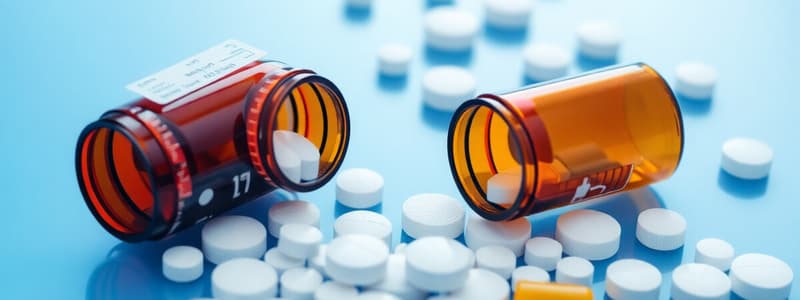Podcast
Questions and Answers
Which of the following conditions is NOT associated with an increase in alpha-1-acid glycoprotein (AAG) levels?
Which of the following conditions is NOT associated with an increase in alpha-1-acid glycoprotein (AAG) levels?
What is the primary reason why a drug with high lipophilicity might have a high volume of distribution (Vd)?
What is the primary reason why a drug with high lipophilicity might have a high volume of distribution (Vd)?
Which of the following examples is NOT a drug that typically binds to alpha-1-acid glycoprotein (AAG)?
Which of the following examples is NOT a drug that typically binds to alpha-1-acid glycoprotein (AAG)?
In a patient with hypoalbuminemia, what impact would you expect on the free fraction of a drug that is highly protein-bound?
In a patient with hypoalbuminemia, what impact would you expect on the free fraction of a drug that is highly protein-bound?
Signup and view all the answers
Why is it important to consider the unbound drug concentration when determining drug efficacy and potential toxicity?
Why is it important to consider the unbound drug concentration when determining drug efficacy and potential toxicity?
Signup and view all the answers
Which of these is NOT a factor affecting unbound drug concentration?
Which of these is NOT a factor affecting unbound drug concentration?
Signup and view all the answers
If a patient's total plasma phenytoin concentration is 18 mg/L and the free fraction is 3.6 mg/L, what can you conclude?
If a patient's total plasma phenytoin concentration is 18 mg/L and the free fraction is 3.6 mg/L, what can you conclude?
Signup and view all the answers
Which of the following drugs is NOT an example of a drug with a high volume of distribution?
Which of the following drugs is NOT an example of a drug with a high volume of distribution?
Signup and view all the answers
Which of the following is NOT a reason why drug metabolites are more readily excreted in urine than their parent drugs?
Which of the following is NOT a reason why drug metabolites are more readily excreted in urine than their parent drugs?
Signup and view all the answers
What is the primary purpose of Phase 1 biotransformation reactions?
What is the primary purpose of Phase 1 biotransformation reactions?
Signup and view all the answers
Which of the following is an example of a Phase 2 biotransformation reaction?
Which of the following is an example of a Phase 2 biotransformation reaction?
Signup and view all the answers
Which functional group is MOST likely to undergo sulfation during Phase 2 biotransformation?
Which functional group is MOST likely to undergo sulfation during Phase 2 biotransformation?
Signup and view all the answers
What is the primary role of CYP450 enzymes in drug metabolism?
What is the primary role of CYP450 enzymes in drug metabolism?
Signup and view all the answers
Which of the following enzymes is NOT involved in Phase 1 biotransformation?
Which of the following enzymes is NOT involved in Phase 1 biotransformation?
Signup and view all the answers
Which of the following is an example of a drug that undergoes N-demethylation?
Which of the following is an example of a drug that undergoes N-demethylation?
Signup and view all the answers
Which of the following statements about Phase 2 biotransformation is FALSE?
Which of the following statements about Phase 2 biotransformation is FALSE?
Signup and view all the answers
What is the primary function of cytochrome P450 (CYP) enzymes in drug metabolism?
What is the primary function of cytochrome P450 (CYP) enzymes in drug metabolism?
Signup and view all the answers
Which of the following enzymes is involved in the deconjugation of sulfate conjugates?
Which of the following enzymes is involved in the deconjugation of sulfate conjugates?
Signup and view all the answers
Which of the following scenarios describes the primary mechanism of acetaminophen detoxification?
Which of the following scenarios describes the primary mechanism of acetaminophen detoxification?
Signup and view all the answers
Which of the following drugs undergoes metabolism to form a more active metabolite?
Which of the following drugs undergoes metabolism to form a more active metabolite?
Signup and view all the answers
What is the main consequence of enzyme induction?
What is the main consequence of enzyme induction?
Signup and view all the answers
Which of the following is an example of an enzyme inducer?
Which of the following is an example of an enzyme inducer?
Signup and view all the answers
Which of the following consequences is associated with enzyme inhibition?
Which of the following consequences is associated with enzyme inhibition?
Signup and view all the answers
Which of the following is an example of an enzyme inhibitor?
Which of the following is an example of an enzyme inhibitor?
Signup and view all the answers
Which of the following factors does NOT directly influence the distribution of drugs in the body?
Which of the following factors does NOT directly influence the distribution of drugs in the body?
Signup and view all the answers
A drug with a high lipid solubility is likely to:
A drug with a high lipid solubility is likely to:
Signup and view all the answers
What is the primary reason for the initial rapid decline in plasma drug concentration after intravenous administration?
What is the primary reason for the initial rapid decline in plasma drug concentration after intravenous administration?
Signup and view all the answers
Which of the following is NOT a similarity between plasma level time curves and tissue distribution curves after IV administration?
Which of the following is NOT a similarity between plasma level time curves and tissue distribution curves after IV administration?
Signup and view all the answers
Which of the following is an example of a drug that would likely follow a one-compartment distribution model?
Which of the following is an example of a drug that would likely follow a one-compartment distribution model?
Signup and view all the answers
In a two-compartment model, the initial distribution phase involves:
In a two-compartment model, the initial distribution phase involves:
Signup and view all the answers
Which of the following conditions is likely to affect drug distribution by altering blood flow to organs?
Which of the following conditions is likely to affect drug distribution by altering blood flow to organs?
Signup and view all the answers
Which of the following statements regarding the blood-brain barrier (BBB) is TRUE?
Which of the following statements regarding the blood-brain barrier (BBB) is TRUE?
Signup and view all the answers
What is the primary consequence of phenytoin displacement from its binding sites by valproic acid?
What is the primary consequence of phenytoin displacement from its binding sites by valproic acid?
Signup and view all the answers
Which of these is NOT a potential symptom of phenytoin toxicity?
Which of these is NOT a potential symptom of phenytoin toxicity?
Signup and view all the answers
What is the primary factor that determines the volume of distribution (Vd) of a drug?
What is the primary factor that determines the volume of distribution (Vd) of a drug?
Signup and view all the answers
If a drug has a small volume of distribution (Vd), what does this suggest about its distribution?
If a drug has a small volume of distribution (Vd), what does this suggest about its distribution?
Signup and view all the answers
What is the purpose of administering a loading dose?
What is the purpose of administering a loading dose?
Signup and view all the answers
Which variable in the equation for oral loading dose accounts for the drug's bioavailability?
Which variable in the equation for oral loading dose accounts for the drug's bioavailability?
Signup and view all the answers
According to the provided information, which of the following drugs has a large volume of distribution (Vd)?
According to the provided information, which of the following drugs has a large volume of distribution (Vd)?
Signup and view all the answers
Which of the following statements accurately describes the relationship between a drug's volume of distribution (Vd) and its distribution into tissues?
Which of the following statements accurately describes the relationship between a drug's volume of distribution (Vd) and its distribution into tissues?
Signup and view all the answers
Which of the following organs is NOT part of the central compartment?
Which of the following organs is NOT part of the central compartment?
Signup and view all the answers
What is the primary reason why drug elimination occurs mainly from the central compartment?
What is the primary reason why drug elimination occurs mainly from the central compartment?
Signup and view all the answers
Which of these components primarily binds to basic drugs?
Which of these components primarily binds to basic drugs?
Signup and view all the answers
Which of the following statements is TRUE regarding drug distribution in the body?
Which of the following statements is TRUE regarding drug distribution in the body?
Signup and view all the answers
What happens to the free drug concentration in plasma during hypoalbuminemia?
What happens to the free drug concentration in plasma during hypoalbuminemia?
Signup and view all the answers
Which of these describes a condition where there is less albumin available for drug binding?
Which of these describes a condition where there is less albumin available for drug binding?
Signup and view all the answers
Which of the following drugs is NOT typically bound to albumin?
Which of the following drugs is NOT typically bound to albumin?
Signup and view all the answers
Which of the following statements is TRUE regarding drug elimination?
Which of the following statements is TRUE regarding drug elimination?
Signup and view all the answers
Flashcards
Factors influencing drug distribution
Factors influencing drug distribution
Factors include organ blood perfusion, lipid solubility, pH differences, protein binding, and disease states.
Organ Blood Perfusion
Organ Blood Perfusion
Highly perfused organs like heart, liver, and kidneys receive drugs more rapidly due to their blood flow.
Lipid Solubility
Lipid Solubility
Lipid-soluble (lipophilic) drugs can easily cross cell membranes and distribute in tissues.
Protein Binding
Protein Binding
Signup and view all the flashcards
Distribution Phase in Plasma Curve
Distribution Phase in Plasma Curve
Signup and view all the flashcards
Plasma vs. Tissue Distribution Curves
Plasma vs. Tissue Distribution Curves
Signup and view all the flashcards
One-Compartment Model
One-Compartment Model
Signup and view all the flashcards
Two-Compartment Model
Two-Compartment Model
Signup and view all the flashcards
Central Compartment
Central Compartment
Signup and view all the flashcards
Peripheral Compartment
Peripheral Compartment
Signup and view all the flashcards
Drug Elimination
Drug Elimination
Signup and view all the flashcards
Albumin
Albumin
Signup and view all the flashcards
Alpha-1-Acid Glycoprotein
Alpha-1-Acid Glycoprotein
Signup and view all the flashcards
Lipoproteins
Lipoproteins
Signup and view all the flashcards
Phenytoin Binding
Phenytoin Binding
Signup and view all the flashcards
Hypoalbuminemia Effects
Hypoalbuminemia Effects
Signup and view all the flashcards
Normal binding of drugs
Normal binding of drugs
Signup and view all the flashcards
Acute-phase proteins
Acute-phase proteins
Signup and view all the flashcards
Alpha-1-acid glycoprotein (AAG)
Alpha-1-acid glycoprotein (AAG)
Signup and view all the flashcards
High volume of distribution (Vd)
High volume of distribution (Vd)
Signup and view all the flashcards
Factors increasing Vd
Factors increasing Vd
Signup and view all the flashcards
Importance of measuring unbound drugs
Importance of measuring unbound drugs
Signup and view all the flashcards
Conditions affecting unbound drug concentration
Conditions affecting unbound drug concentration
Signup and view all the flashcards
Cytochrome P450 (CYP)
Cytochrome P450 (CYP)
Signup and view all the flashcards
CYP3A4
CYP3A4
Signup and view all the flashcards
UDP-glucuronosyltransferase (UGT)
UDP-glucuronosyltransferase (UGT)
Signup and view all the flashcards
Glutathione S-transferase (GST)
Glutathione S-transferase (GST)
Signup and view all the flashcards
Phase 1 Metabolism
Phase 1 Metabolism
Signup and view all the flashcards
Enzyme Induction
Enzyme Induction
Signup and view all the flashcards
Enzyme Inhibition
Enzyme Inhibition
Signup and view all the flashcards
Codeine and Morphine
Codeine and Morphine
Signup and view all the flashcards
Displacement of Drugs
Displacement of Drugs
Signup and view all the flashcards
Phenytoin
Phenytoin
Signup and view all the flashcards
Valproic Acid
Valproic Acid
Signup and view all the flashcards
Volume of Distribution (Vd)
Volume of Distribution (Vd)
Signup and view all the flashcards
Small Vd
Small Vd
Signup and view all the flashcards
Large Vd
Large Vd
Signup and view all the flashcards
Loading Dose (LD)
Loading Dose (LD)
Signup and view all the flashcards
Oral Loading Dose Equation
Oral Loading Dose Equation
Signup and view all the flashcards
Purpose of Biotransformation
Purpose of Biotransformation
Signup and view all the flashcards
Why Metabolites are Excreted More Easily
Why Metabolites are Excreted More Easily
Signup and view all the flashcards
Phase 1 Biotransformation
Phase 1 Biotransformation
Signup and view all the flashcards
Examples of Phase 1 Reactions
Examples of Phase 1 Reactions
Signup and view all the flashcards
Phase 2 Biotransformation
Phase 2 Biotransformation
Signup and view all the flashcards
Examples of Phase 2 Reactions
Examples of Phase 2 Reactions
Signup and view all the flashcards
Dealkylation Process
Dealkylation Process
Signup and view all the flashcards
Functional Groups for Phase 2 Reactions
Functional Groups for Phase 2 Reactions
Signup and view all the flashcards
Study Notes
Drug Distribution
- Factors affecting drug distribution include organ blood perfusion, lipid solubility, regional differences in pH, and the extent of protein binding.
- Highly perfused organs receive drugs more quickly.
- Lipophilic drugs cross membranes more readily.
- Bound drugs are restricted to plasma, while unbound drugs distribute freely.
- Disease states and special anatomical barriers can alter distribution.
Plasma and Tissue Distribution Curves
- Plasma concentration curves show rapid initial decline due to distribution into tissues followed by slower decline due to elimination.
- Tissue concentration curves show a gradual increase as the drug distributes, peaking before slowly decreasing due to elimination.
- The distribution phase is marked between 0 to ~2 hours, representing the movement of drugs from plasma to tissues.
- Both curves eventually decline due to drug elimination.
Compartmental Models
- The one-compartment model assumes instantaneous distribution throughout the body, with no delay in equilibrium between plasma and tissues. Examples are aminoglycosides.
- The two-compartment model assumes an initial distribution phase where drugs move from central (plasma) to peripheral (tissues) compartments, followed by elimination. Examples are lipophilic drugs like digoxin.
- Central compartments include highly perfused organs (heart, liver, kidneys, lungs, blood plasma), and less perfused tissues (muscle, fat, skin, bone, CSF) are peripheral compartments.
Drug Elimination
- Elimination primarily occurs in the central compartment.
- Important organs for elimination are the liver (metabolism) and kidneys (excretion).
- Lungs can eliminate volatile drugs.
- The metabolic process converts lipophilic drugs into hydrophilic metabolites.
- Increased water solubility leads to easier renal excretion.
- Decreased ability to cross membranes prevents reabsorption in renal tubules.
Protein Binding
- Albumin is the most abundant plasma protein binding site.
- Alpha-1-acid glycoprotein binds to basic drugs.
- Lipoproteins bind to lipophilic drugs.
- Red blood cells can bind certain drugs (phenytoin, cyclosporine).
- Hypoalbuminemia can cause a higher amount of free drug in the blood, potentially leading to toxicity.
Acute-Phase Proteins
- Acute-phase proteins increase in plasma during inflammation, infection, trauma, and stress.
- Alpha-1-acid glycoprotein (AAG) is an example.
Volume of Distribution (Vd)
- Vd is a pharmacokinetic parameter that shows how extensively a drug distributes throughout the body compared to plasma.
- A large Vd indicates extensive tissue distribution.
- A small Vd indicates the drug stays primarily in plasma.
Loading Dose
- Loading dose (LD) is the initial higher dose given to rapidly achieve therapeutic drug levels in the body.
Drug Metabolism
- Biotransformation (metabolism) converts lipophilic drugs into more soluble metabolites for excretion (e.g., water-soluble urine metabolites).
- Detoxification processes (inactivation) can eliminate active drug metabolites.
- Increased water solubility and reduced membrane reabsorption enhance renal excretion.
Studying That Suits You
Use AI to generate personalized quizzes and flashcards to suit your learning preferences.
Related Documents
Description
Test your knowledge on drug distribution factors, plasma and tissue distribution curves, and compartmental models in pharmacology. Understand how different parameters influence the speed and extent of drug distribution within the body. This quiz is designed for students studying advanced pharmacology concepts.



